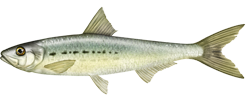Pacific sardine
| Pacific sardine | ||||||||||||
|---|---|---|---|---|---|---|---|---|---|---|---|---|

Pacific sardine ( Sardinops sagax ), here the subspecies Sardinops sagax caeruleus . |
||||||||||||
| Systematics | ||||||||||||
|
||||||||||||
| Scientific name of the genus | ||||||||||||
| Sardinops | ||||||||||||
| Hubbs , 1929 | ||||||||||||
| Scientific name of the species | ||||||||||||
| Sardinops sagax | ||||||||||||
| ( Jenyns , 1842) |
The Pacific sardine ( Sardinops sagax ) is a herring-like schooling fish of the tropical and subtropical Pacific. The Red List of Endangered Species classifies it as "not threatened". In the past, the subspecies were classified as separate species in the genus Sardinops , today Sardinops sagax is the only species of the genus monotypical . The Pacific sardine occupies an important position in the commercial fishery .
description
The Pacific sardine has a spindle-shaped body and a relatively large head with large eyes. They usually reach a standard height of about eight inches . The eyes have so-called fat eyelids . There are a number of small, dark spots along the silvery flanks. The back shows a blue-green color. All fins consist exclusively of soft rays . The dorsal fin contains 13 to 21 rays, the anal fin 12 to 23. The caudal fin is split.
Distribution, habitat and biology
The distribution area of the Pacific sardine extends from the west coast of the American double continent over the Pacific , the Malay Archipelago and the Indo-Pacific region to the coasts of Africa , there also to the Atlantic coast .
The population is divided into five different subspecies , Sardinops sagax sagax in the waters around Chile , Sardinops sagax caeruleus in California , Sardinops sagax melanosticus in Japan , Sardinops sagax neopilchardus in Australia and Sardinops sagax ocellatus around Africa. California populations migrate north in early summer and return in fall.
The Pacific sardine lives in large pelagic schools near the coast. Occasionally shoals are formed with the Japanese mackerel . Larvae and eggs are also pelagic. Young animals feed on zooplankton , adults mainly on phytoplankton .
swell
literature
- Peter JP Whitehead: Clupeoid fishes of the world (Suborder Clupeoidei). An annotated and illustrated catalog of the herrings, sardines, pilchards, sprats, shads, anchovies, and wolf-herrings. Part 1. Chirocentridae, Clupeidae and Pristigasteridae FAO Species Catalog for Fishery Purposes. No. 7th FAO Rome 2005. ( PDF )
Individual evidence
- ↑ a b c d e f Sardinops sagax on Fishbase.org (English)
- ↑ Bruce B. Colette, Cornelia E. Brauen (Eds.): Scombrids of the world. An annotated and illustrated catalog of tunas, mackerels, bonitos and related species known to date. FAO Species Catalog Vol.2., Rome 1983. ( PDF )
Web links
- Sardinops sagax on Fishbase.org (English)
- Sardinops sagax on the FAO website
